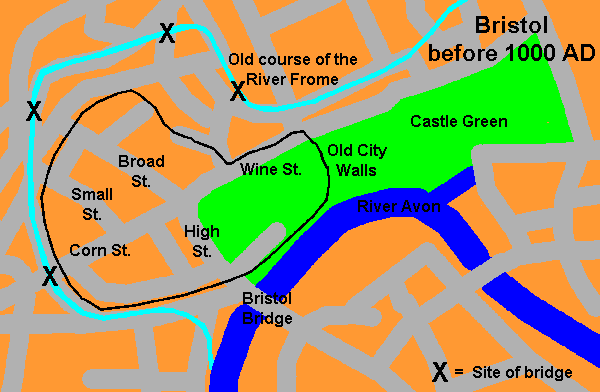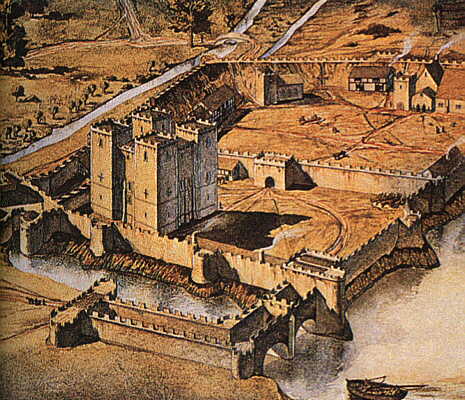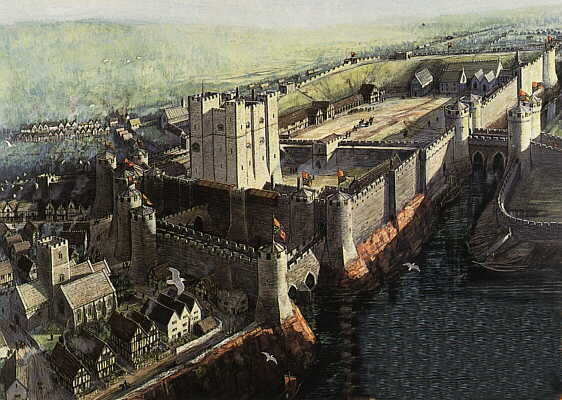Exactly when the city was founded is unknown. The earliest relic is a silver coin in the Royal Collection at Stockholm, Sweden. The coin bears the image of Ethelred Unrede (978 - 1016) and was minted in Bricgstowe (Bristol) by a man named Aelfweld. If Bristol was important enough to have a mint by 978 it must have been in existance sometime before then.
It is fairly certain that no town existed here before 577 AD. The reason being that in 577 two Saxon kings (Cuthwine and Ceawlin) fought and killed three British kings (Commail, Condidan and Farinmail) at a village called Dyrham near Pucklechurch, just outside of the present city. Although the towns of Bath, Gloucester and Cirencester are mentioned in the account of this battle, Bristol isn't mentioned at all, even though it would have been closer than those mentioned.
Thus, Bristol was founded sometime between 577 and 978 AD. Even by this latter date the town was known to be dealing sending slaves to the Vikings in Dublin, Ireland.
Bridges at this time were of vital importance. There are three reasons why Bristol, as a port, is situated 7 miles inland with access to ships up a very tortuous river. A bridge across the Avon nearer it's mouth would have been technologically very difficult, the land there was very prone to flooding and the town would have been very exposed to attack. Ships would make their way up the Avon until they reached Bristol Bridge and lay beached at low tide on the mud ready to be unloaded.

Bristol ~ before 1000 AD (the area enclosed by the Old City Walls)
The named streets are still in existence.
Being built in the crook of the River Frome next to the River Avon provided Bristol with near perfect protection. The building of a wall around the town further increased its fortifications. A walk around the area bounded by the old city walls - even though they don't exist now, except for the old St. John's Gate at the bottom of Broad Street - is a very pleasant way of spending an hour or so.
About the time of the Norman conquest (1066), the Manor of Barton, in which Bristol was situated, had to pay the Governor £28 and the King £73.35 in taxes. This was in the days when money was worth many, many times what it is today. To give an idea of how much this was only four other towns, London, York, Lincoln and Norwich paid more. Although only in existance for a couple of hundred years at the most, Bristol was already a prosperous town.
In 1051 Bristol was part of the Earldom of Swegen. Swegen was the eldest son of Earl Godwin. Later that year Godwin, Swegen and his brother, Harold were exiled and went to live in Ireland. In 1068 three sons of Harold (and their followers) tried to take the city by force but were repulsed.
It became apparent that what Bristol needed was a stronger defence. Although Bristol had offered no resistance to William the Conquerer, he probably thought that a castle might also overawe the locals and secure their allegience. Geoffrey Mowbray, Bishop of Coutances was put in charge of the work. Mowbray has been described as an unpriestlike Bishop, more accustomed to the mace and sword than the mass-book. The castle was built on the part of Castle Green (see map above) next to the town and the town walls extended to become continuous with the castle's. Geoffrey died in 1093 and the castle was handed over to Robert FitzHamon.
In 1106 FitzHamon built St. Peter's church. Although the Castle was demolished in 1665, on the orders of Oliver Cromwell, the remains of St. Peter's are still on Castle Green. It managed to survive more than 800 years, up until Sunday, 24th November 1940 when it was hit by a bomb during the Second World War. All that remains now is the tower and exterior walls.

St. Peter's church ~ built 1106, destroyed 24th November 1940
The photo was taken from a balloon ~ July 1999
Robert FitzHamon died from wounds received whilst fighting for King Henry I against Robert, Duke of Normandy. His daughter, Mabel, was married off to Henry I's illegitimate son, Robert of Caen (there are too many Robert's here for my liking - it gets confusing) who was made the Earl of Gloucester. He greatly enhanced the castles defences and using stone from Caen, France built a Keep for the castle. This was a huge affair being 110 ft by 95 ft at its base. The walls were 25 feet thick at the base and 9 1/2 feet thick at the top. The only keeps bigger were at the Tower of London and at Colchester.

Bristol Great Keep

Bristol Castle

Another image of Bristol Castle
I have no idea where these pictures come from or who painted them - this particular perspective seems to be very popular.
Robert of Caen also built St. Ewen's church at the corner of Broad and Corn streets. This building still stands, only now it is known as 'Christchurch, incorporating St Ewen's and St George'. Robert of Caen aka the Earl of Gloucester aka Robert of Gloucester died in 1147.

The clock of Christchurch - corner of Corn St. and Broad St.
This clock still works, and on the hour the men tap the bells with the hammers.
During the reign of Edward I he gave the castle to his Queen, Eleanor of Castile, who rented it out to the Mayor of Bristol. For this reason Bristol at the time was called the "Queen's Chamber".
Before you leave this page I would ask you to ask yourself why such massive defences for English cities were built.
This was not the time 'Merrie Olde Englande' - if such a thing ever existed. British society at the time was deeply divided, at the bottom were slaves, then there were the majority of the population - the half free, what the Normans called 'villeins'. These may or may not have had land or work of their own, but they all had an obligation to work for the Lords of the land - and pay taxes as well as or instead of work. This obligation also extended to going to war for the lords. At the top of society were the Lords and later the Bishops.
The Lords built the Castles and the Churches. They more or less had the priests in their pockets and between them the commoners were told what to do and how to act. Although laws were in existence, peoples day to day living was still dominated by tradition and custom.
Not only that, but practically everyone seemed to be want to be king. As one lord fell out of favour then you can bet someone else was looking longingly at their possessions. This in turn to led to fighting which would involve whole towns and villages. The Welsh, Cornish and Scottish could hardly be called civilised by anyone's standards and much fighting and skirmishing took place along England's borders.
The population too, were divided by language. Most of the English were descended from the Saxons and spoke English. Hardly anyone could read or write. The church used Latin and the new invaders from Normandy spoke French.
To give an example, between the Norman Conquest of 1066 and the Black Death of 1348, England enjoyed only one period of domestic peace that lasted more than 30 years.
In April 2005, I got an email from Luke Rowlands who clarified the languages in use at various times. At the time of the coming of the Romans, the population in the Bristol area - and over most of England - spoke a form of Brythonic (Welsh) - this population remained until the invasion of the Saxons who brought their Germanic language with them - English. Having never heard of Brythonic, I looked it up. Wikipedia said (now changed when I checked in 2022) that "A few British survivals are thought to be largely or wholly Brythonic in origin: some place-names (bre-, bal-, and -dun for hills, carr for a high rocky place, coomb for a small deep valley); domestic words (hubbub, iron, peat, bucket, crock, noggin, gob, nook); and folk-names for badgers (brock) and their burrows (set)."
This page created August 3, 2000, last modified June 19, 2022





